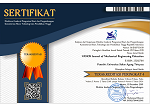Characteristics of Hybrid Composite from Hydroxyapatite/Metal Powder and Ceramic
Abstract
Keywords
Full Text:
PDFReferences
Hasanudin, D. (2008). Sate Bandeng Becomes Hurry Tourists. Banten News. Banten Culinary Tourism.
Pramono, A. (2018). Innovation of Self High-Propagating Temperature Shyntesis (SHS) Technology as Processign of Fish Bone for Hybrid Composite Material Applications. Report of research grants, University of Sultan Ageng Tirtayasa Development as a Center of Excellence Food Security.
Boutinguiza, M. Pou, J. Comesaña, Lusquiños, R. De-Carlos, A and León, B. (2012). Biological hydroxyapatite obtained from fish bones. Materials Science and Engineering C 32. 478–486.
Johansson, P., Jimbo, R., Kozai, Y., Sakurai, T., Kjellin, P., Currie, F. and Wennerberg, A. (2015). Nanosized Hydroxyapatite Coating on PEEK Implants Enhances Early Bone Formation: A Histological and Three-Dimensional Investigation in Rabbit Bone. Materials. 8 (7): 3815-3830.
Nayak, A.K., Laha, B. and Sen, K. (2011). Development of Hydroxyapatite (HAp)-Ciprofloxacin Bone-Implants using Quality by Design, Acta Pharmaceutica. 61: 25-36.
Robi’atul, A. Adawiyah, Selviastuti, R. and Serburia. (2014). Milkfish Supplements with Alginate Capsule Shell to Prevent Osteoporosis. Student Scientific Journal, Faculty of Public Health, Diponegoro University, UNDIP. Vol. 4 No.1.
Purnomo, T. (2007). Analysis of Lead Content (Pb) in Milkfish (Chanos chanos Forsk.) In the Pond of Gresik Subdistrict. Neptune National Journal - Surabaya State University Indonesia. Vol. 14, No. 1: 68 – 77.
Pramono, A. Kollo, L. Kallip, K. Veinthal, R and Gomon J.K. (2014). Heat Treatment of Ultrafine Grained High - Strength Aluminum Alloy, Key Engineering Materials Vol. 604: 273-276.
Pramono, A. (2008). Composites as a Future Technology Trend - Theory and Application. Fantasy Explosive Part public lecture part 2. Department of Metallurgy - Faculty of Engineering. University of Sultan Ageng Tirtayasa.
Pramono, A (2018). Teaching Materials Subject. Book of Refferences. The Composite Materials - Technology and Application. Department of Metallurgy - Faculty of Engineering, University of Sultan Ageng Tirtayasa.
Pramono, A. Kommel, L. Kollo, L and Veinthal, R. (2016). The Aluminum Based Composite Produced by Self Propagating High Temperature Synthesis (SHS). Materials Science (MEDŽIAGOTYRA). Vol. 22, (1): 40-44.
Agrafiotis, C.C., and Zaspalis, V.T. (2004). SHS of MnZn - Ferrites for Inductor Application. Journal of Magnetism and Magnetic Material 283: 364 – 374.
Aminika, B. (2012). Investigation of The Pre-Milling Effect on Synthesis of Nanocrystalline TiB2–TiC Composite Prepared by SHS Method. Science Direct Powder Technology 232: 78 – 86.
Pramono A, Sulaiman F, Suryana and Milandia A. (2019). Calcination process on chanos chanos forsk (CCF) of milkfish bones to get Hydroxyapatite (HAp) as Composites Application. IOP Conf. Series: Materials Science and Engineering. Vol 532 (1): 1-9.
El-Din, H and El-Shiekh, F. (2002) Finite Element Simulation of Hip Joint Replacement under Static and Dynamic Loading. Research - Doctor of Philosophy. School of Mechanical and Manufacturing Engineering. Dublin City University, Skotlandia.
Keaveny, T. M., Morgan, E. F. and Yeh, O. C. (2004). Bone Mechanics. Usa: Standard Handbook of Biomedical Engineering and Design.
Pramono, A. Milandia, A. Dhoska, K and Kommel, L. (2018). Properties of Metal Matrix Composites by Pressureless Infiltration (PRIMEXX). Proceedings Book The 8th of Annual BASIC Science International Conferences. March 6-7: 272-279.
Pramono A, Sulaiman F, Sryana, Alfirano and Milandia A. (2020). Effect of Pressure Distribution on Hydroxyapatite (HAp) Based Hybrid Composites Made from the Milkfish Bones. Materials Science Forum. 988: 182-191.
Slósarczyk, A. Czechowska, J. Cicho´n, E and Zima, A. (2020). New Hybrid Bioactive Composites for Bone Substitution. Processes-MDPI (8): 335.
Czechowska, J. Zima, A. Paszkiewicz, Z. Lis, J and Slósarczyk, A. (2014). Physicochemical properties and biomimetic behaviour of α-TCP-chitosan based materials. Ceramic. Int. 40: 5523–5532
DOI: http://dx.doi.org/10.30870/vanos.v5i2.8931
Refbacks
- There are currently no refbacks.

This work is licensed under a Creative Commons Attribution 4.0 International License.


.png)
.png)
